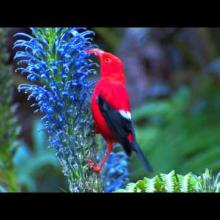

Join BirdNote tomorrow, November 30th!
Illustrator David Sibley and actor H. Jon Benjamin will face off in the bird illustration battle of the century during BirdNote's Year-end Celebration and Auction!
Because of invasive species and climate change, many of the native birds of Hawai‘i are endangered or have gone extinct. Sam ‘Ohu Gon, Senior Scientist and Cultural Advisor for the Nature Conservancy of Hawai'i, says the bright red bird called the ‘i‘iwi holds a special place in native Hawaiian culture. The bird’s feathers appear as the red color in traditional Hawaiian featherwork. Preserving the bird means preserving the strong cultural relationship with the species.
BirdNote®
Sam ‘Ohu Gon on Protecting the ‘I‘iwi
Written by Mark Bramhill
Mark Bramhill: This is BirdNote.
[‘I‘iwi song, ML5843]
Because of invasive species and climate change, many of the native birds of Hawai‘i are endangered or have gone extinct. Sam ‘Ohu Gon, Senior Scientist and Cultural Advisor for the Nature Conservancy of Hawai'i, says the ‘i‘iwi holds a special place in native Hawaiian culture. The bright red honeycreeper is one of the largest native forest birds.
[‘I‘iwi song, ML5843]
Sam ‘Ohu Gon: When an ‘i‘iwi flies down into a ohia, a tree that has birds such as Apapāne or Amakahi in it, they all vacate because the ‘i‘iwi is the dominant bird there. And Hawaiians notice that — and the ‘i‘iwi is the symbol of royalty, and the ‘i‘iwi was the bird that provided the scarlet, the brilliant red of Hawaiian featherwork. And so, because the ‘i‘iwi is the last extant Hawaiian featherwork bird, it is the last living connection to that huge part of Hawaiian culture.
[‘I‘iwi song, ML5843]
And so it's almost unthinkable to me that the ‘i‘iwi should be allowed to go extinct, because then we would read about Hawaiian featherwork and how spectacular it was, and it would all be historical, and all be in the past — no living reminder of those times.
[‘I‘iwi song, ML5843]
I've seen and heard this spectacular bird on Kaua‘i and O‘ahu and Maui and Hawai'i islands, and the fossil record indicates it was on every single island. It always lifts me to experience them in native forests. Their calls take me hundreds of years into the past, into a time of abundance.
[‘I‘iwi song, ML5843]
Hawaiians speak of pilina, which is connection. These birds, they connect us to our ancestors and to our place. They provide a real important part of Hawaiian identity. And that, to me, is definitely worth protecting.
Mark Bramhill: Sam's work tries to bridge traditional Hawaiian knowledge with conservation to ensure birds like the ‘i‘iwi stay with us. Learn more at our website, BirdNote.org. I'm Mark Bramhill.
###
Senior Producer: Mark Bramhill
Producer: Sam Johnson
Managing Editor: Jazzi Johnson
Content Director: Jonese Franklin
Bird sounds provided by The Macaulay Library of Natural Sounds at the Cornell Lab of Ornithology, Ithaca, New York. ML5843 ‘I‘iwi recorded by Doug Pratt.
BirdNote’s theme was composed and played by Nancy Rumbel and John Kessler.
© 2024 BirdNote November 2024
Narrator: Mark Bramhill
ID# iiwi-01-2024-11-04 iiwi-01



